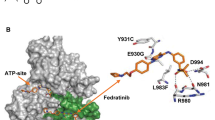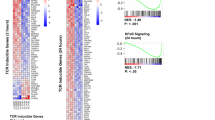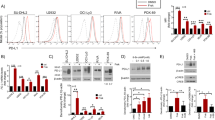Abstract
Calcineurin is a calcium-activated serine/threonine phosphatase critical to a number of developmental processes in the cardiovascular, nervous and immune systems. In the T-cell lineage, calcineurin activation is important for pre–T-cell receptor (TCR) signaling, TCR-mediated positive selection of thymocytes into mature T cells, and many aspects of the immune response1,2. The critical role of calcineurin in the immune response is underscored by the fact that calcineurin inhibitors, such as cyclosporin A (CsA) and FK506, are powerful immunosuppressants in wide clinical use. We observed sustained calcineurin activation in human B- and T-cell lymphomas and in all mouse models of lymphoid malignancies analyzed. In intracellular NOTCH1 (ICN1)- and TEL-JAK2–induced T-cell lymphoblastic leukemia3,4,5, two mouse models relevant to human malignancies6,7,8, in vivo inhibition of calcineurin activity by CsA or FK506 induced apoptosis of leukemic cells and rapid tumor clearance, and substantially prolonged mouse survival. In contrast, ectopic expression of a constitutively activated mutant of calcineurin favored leukemia progression. Moreover, CsA treatment induced apoptosis in human lymphoma and leukemia cell lines. Thus, calcineurin activation is critical for the maintenance of the leukemic phenotype in vivo, identifying this pathway as a relevant therapeutic target in lymphoid malignancies.
This is a preview of subscription content, access via your institution
Access options
Subscribe to this journal
Receive 12 print issues and online access
$209.00 per year
only $17.42 per issue
Buy this article
- Purchase on Springer Link
- Instant access to full article PDF
Prices may be subject to local taxes which are calculated during checkout




Similar content being viewed by others
References
Neilson, J.R., Winslow, M.M., Hur, E.M. & Crabtree, G.R. Calcineurin B1 is essential for positive but not negative selection during thymocyte development. Immunity 20, 255–266 (2004).
Bueno, O.F., Brandt, E.B., Rothenberg, M.E. & Molkentin, J.D. Defective T cell development and function in calcineurin A β-deficient mice. Proc. Natl. Acad. Sci. USA 99, 9398–9403 (2002).
Pear, W.S. et al. Exclusive development of T cell neoplasms in mice transplanted with bone marrow expressing activated Notch alleles. J. Exp. Med. 183, 2283–2291 (1996).
Carron, C. et al. TEL-JAK2 transgenic mice develop T-cell leukemia. Blood 95, 3891–3899 (2000).
Aster, J.C. et al. Essential roles for ankyrin repeat and transactivation domains in induction of T-cell leukemia by notch1. Mol. Cell. Biol. 20, 7505–7515 (2000).
Lacronique, V. et al. A TEL-JAK2 fusion protein with constitutive kinase activity in human leukemia. Science 278, 1309–1312 (1997).
Benekli, M., Baer, M.R., Baumann, H. & Wetzler, M. Signal transducer and activator of transcription proteins in leukemias. Blood 101, 2940–2954 (2003).
Weng, A.P. et al. Activating mutations of NOTCH1 in human T cell acute lymphoblastic leukemia. Science 306, 269–271 (2004).
Hogan, P.G., Chen, L., Nardone, J. & Rao, A. Transcriptional regulation by calcium, calcineurin, and NFAT. Genes Dev. 17, 2205–2232 (2003).
Crabtree, G.R. & Olson, E.N. NFAT signaling: choreographing the social lives of cells. Cell 109 Suppl,, S67–S79 (2002).
Macian, F. NFAT proteins: key regulators of T-cell development and function. Nat. Rev. Immunol. 5, 472–484 (2005).
Dumortier, A. et al. Notch activation is an early and critical event during T-cell leukemogenesis in Ikaros-deficient mice. Mol. Cell. Biol. 26, 209–220 (2006).
Blyth, K. et al. Sensitivity to myc-induced apoptosis is retained in spontaneous and transplanted lymphomas of CD2-mycER mice. Oncogene 19, 773–782 (2000).
Decaudin, D. et al. High efficacy of combined rituximab and gemcitabine on Epstein-Barr virus-associated human B-cell lymphoma obtained after Hodgkin's xenograft in immunodeficient mice. Anticancer Drugs 17, 685–695 (2006).
Dos Santos, N.R. et al. Pre-TCR expression cooperates with TEL-JAK2 to transform immature thymocytes and induce T-cell leukemia. Blood 109, 3972–3981 (2007).
Ke, H. & Huai, Q. Structures of calcineurin and its complexes with immunophilins-immunosuppressants. Biochem. Biophys. Res. Commun. 311, 1095–1102 (2003).
O'Keefe, S.J., Tamura, J., Kincaid, R.L., Tocci, M.J. & O'Neill, E.A. FK-506- and CsA-sensitive activation of the interleukin-2 promoter by calcineurin. Nature 357, 692–694 (1992).
Ranger, A.M. et al. The nuclear factor of activated T cells (NFAT) transcription factor NFATp (NFATc2) is a repressor of chondrogenesis. J. Exp. Med. 191, 9–22 (2000).
Glud, S.Z. et al. A tumor-suppressor function for NFATc3 in T-cell lymphomagenesis by murine leukemia virus. Blood 106, 3546–3552 (2005).
Jauliac, S. et al. The role of NFAT transcription factors in integrin-mediated carcinoma invasion. Nat. Cell Biol. 4, 540–544 (2002).
Neal, J.W. & Clipstone, N.A. A constitutively active NFATc1 mutant induces a transformed phenotype in 3T3–L1 fibroblasts. J. Biol. Chem. 278, 17246–17254 (2003).
Marafioti, T. et al. The NFATc1 transcription factor is widely expressed in white cells and translocates from the cytoplasm to the nucleus in a subset of human lymphomas. Br. J. Haematol. 128, 333–342 (2005).
Pham, L.V., Tamayo, A.T., Yoshimura, L.C., Lin-Lee, Y.C. & Ford, R.J. Constitutive NF-κB and NFAT activation in aggressive B-cell lymphomas synergistically activates the CD154 gene and maintains lymphoma cell survival. Blood 106, 3940–3947 (2005).
Buchholz, M. et al. Overexpression of c-myc in pancreatic cancer caused by ectopic activation of NFATc1 and the Ca2+/calcineurin signaling pathway. EMBO J. 25, 3714–3724 (2006).
Pui, C.H. et al. Extended follow-up of long-term survivors of childhood acute lymphoblastic leukemia. N. Engl. J. Med. 349, 640–649 (2003).
Abramson, J.S. & Shipp, M.A. Advances in the biology and therapy of diffuse large B-cell lymphoma: moving toward a molecularly targeted approach. Blood 106, 1164–1174 (2005).
Morita, S., Kojima, T. & Kitamura, T. Plat-E: an efficient and stable system for transient packaging of retroviruses. Gene Ther. 7, 1063–1066 (2000).
Gavrieli, Y., Sherman, Y. & Ben-Sasson, S.A. Identification of programmed cell death in situ via specific labeling of nuclear DNA fragmentation. J. Cell Biol. 119, 493–501 (1992).
Zhao, W.L. et al. Vascular endothelial growth factor-A is expressed both on lymphoma cells and endothelial cells in angioimmunoblastic T-cell lymphoma and related to lymphoma progression. Lab. Invest. 84, 1512–1519 (2004).
Chuvpilo, S. et al. Alternative polyadenylation events contribute to the induction of NF-ATc in effector T cells. Immunity 10, 261–269 (1999).
Acknowledgements
We thank H. Soilihi, O. Fehri, S. Belhadj and C. Leboeuf for technical assistance; S. Candon for determining blood levels of FK 506 in FK506-treated mice; A. Vincent-Salomon (Institut Curie) for providing the human lymphoma samples; N. Clipstone (Northwestern University) for the cDNA for calcineurinAα; W. Pear (University of Pennsylvania) for the pMig retroviral vector encoding the cDNA for ICN1; G. Crabtree, A. Rao and J. Aramburu for discussions; and C. Tran Quang and M. Von Lindern for critical reading of the manuscript. H.M. was supported by predoctoral fellowships from the Ministère de l'Education Nationale et de la Recherche and the Association pour la Recherche contre le Cancer (ARC). N.R.d.S. was supported by a Marie Curie Fellowship from the European Community program. This work was supported by funds from the Centre National de la Recherche Scientifique (CNRS), Institut Curie, Institut National du Cancer (INCA), Cancéropôle Ile-de-France, Agence Nationale de la Recherche (ANR) and Ligue Nationale contre le Cancer (J.G. and H.d.T. are supported by the Ligue Nationale Contre le Cancer as 'Équipe Labelisée Ligue'). In vivo treatment of mouse tumors was performed and supported by the preclinical mouse platform established by the Alliance de Recherche sur le Cancer (ARECA) program.
Author information
Authors and Affiliations
Contributions
H.M. designed and conducted the in vivo and in vitro experiments and contributed to manuscript writing. H.A., C.B. and M.C.G. assisted in conducting the experiments. N.R.d.S. generated the EμSRα-TEL-JAK2/Cd3e−/− and EμSRα-TEL-JAK2/Rag2−/− compound mice. A.J supervised histological analyses. D.D. provided human tumor samples. H.D.T. designed experiments and contributed to manuscript writing. J.G. designed the project, assisted in conducting experiments and contributed to manuscript writing.
Corresponding author
Ethics declarations
Competing interests
The authors declare no competing financial interests.
Supplementary information
Supplementary Fig. 1
Sustained calcineurin activation in leukemic cells from intracellular NOTCH1-induced T-ALL. (PDF 133 kb)
Supplementary Fig. 2
Sustained calcineurin activation in tumor cells from mouse models of human lymphoma and leukemia. (PDF 232 kb)
Supplementary Fig. 3
Therapeutic treatment of TEL-JAK2-diseased mice with CsA or FK506 induces leukemia regression in bone marrow. (PDF 682 kb)
Supplementary Fig. 4
In vivo antiproliferative effect of FK506 and CsA on TJ2 leukemic cells. (PDF 444 kb)
Supplementary Fig. 5
Sustained calcineurin activation in cell lines derived from human B and T lymphoid malignancies. (PDF 175 kb)
Supplementary Fig. 6
Ectopic expression of a constitutively active mutant of CnA (CnA*) in leukemic cells favors leukemia progression and invasion. (PDF 108 kb)
Supplementary Fig. 7
Increased tumor load in the kidney of mice transplanted with CnA*-transduced TJ2 cells as compared to mice engrafted with mock-transduced TJ2 cells. (PDF 265 kb)
Rights and permissions
About this article
Cite this article
Medyouf, H., Alcalde, H., Berthier, C. et al. Targeting calcineurin activation as a therapeutic strategy for T-cell acute lymphoblastic leukemia. Nat Med 13, 736–741 (2007). https://doi.org/10.1038/nm1588
Received:
Accepted:
Published:
Issue Date:
DOI: https://doi.org/10.1038/nm1588
This article is cited by
-
PD-1 signalling defines and protects leukaemic stem cells from T cell receptor-induced cell death in T cell acute lymphoblastic leukaemia
Nature Cell Biology (2023)
-
Subcutaneous panniculitis-like T-cell lymphoma associated with hemophagocytic lymphohistiocytosis: a systematic review of 63 patients reported in the literature
Clinical and Experimental Medicine (2023)
-
RCAN1-mediated calcineurin inhibition as a target for cancer therapy
Molecular Medicine (2022)
-
Higher expression of calcineurin predicts poor prognosis in unique subtype of ovarian cancer
Journal of Ovarian Research (2019)
-
The calcineurin protein phosphatase is dispensable for BCR-ABL-induced B-ALL maintenance, propagation and response to dasatinib
Leukemia (2017)



